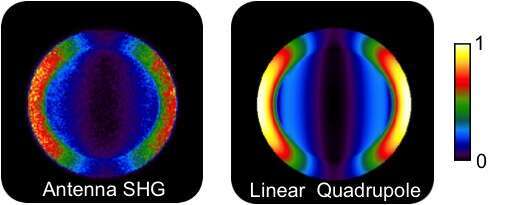
Controlling Second Harmonic Generation with Plasmonic Nanoantennas
Optical antennas enhance light-matter interaction due to their ability to confine electromagnetic fields within nanometric volumes, which may be crucial in future nanophotonic devices. The interference of coexisting multipole moments in a plasmonic structure has been used to direct the emission of quantum dots. However, such configurations are still limited by the fact that we cannot, for example, actively control the emission direction as the phases between different multipoles are predefined by the emitter/antenna geometry. Furthermore, the phase of the fields radiated by single emitters depend highly on their decay rates, which are slow compared to the femtosecond timescale needed. Thus we propose using second harmonic generation directly from plasmonic structures to gain a degree of control over the phase between distinct emitters.
To our knowledge the second harmonic (SH) emission pattern of a single nanostructure has yet to be measured, likely due to low signals. To obtain enough signal, we focus 20 fs pulses from a Ti:Sapphire laser to a diffraction limited spot using a high NA oil-immersion objective and image the SH light generated by the single nanostructures at the objective’s back focal plane. Thus we gain access to the momentum space and directly observe the angular distribution of the SH radiation.

Figure 1. A back focal plane measurement demonstrating the quadrupolar emission pattern from a single Au dipole antenna resonant at the fundamental wavelength.
Our results show that a gold dipole antenna, resonant at the fundamental wavelength (800±40 nm), radiates SH with the pattern of a linear quadrupole. The structure emits light through two channels located at the antenna’s ‘hot spots’ where surface charges of opposite sign accumulate, so they are effectively two dipole emitters necessarily π out of phase with each other. Further measurements show that, through proper antenna design and selection of the polarization state of our excitation beam, we can shape the antenna near fields and control the phase between distinct antenna hot spots and thus select the emission direction of the SH fields. Such a high degree of control over how SH radiates from plasmonic antennas is promising for applications requiring coherent, local emitters such as optical switches or efficient near-field coupling to waveguides.
ion.hancu@icfo.es
Powered by Eventact EMS